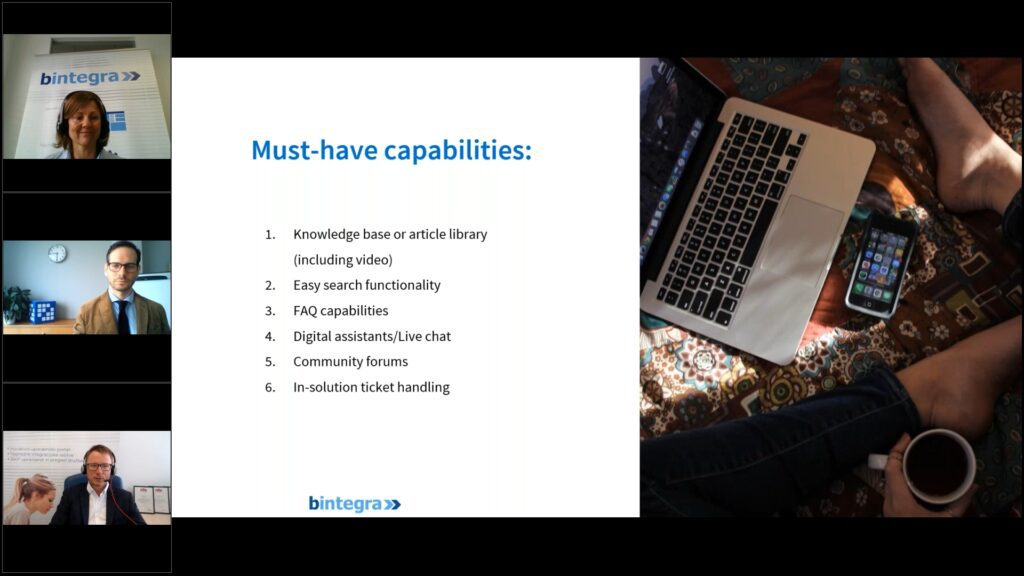Origins of Digital Self-Service
The term Self-Service is not something we invented in last decade. The term originated from a retail grocer in 1917 when American grocer Clarence Saunders filed a patent for his “self-serving store”. Instead of compiling a list of goods for a clerk to retrieve, customers would collect the items they wanted to buy themselves and present them to a cashier before leaving.
The term “Call Centre ” was created in 1983 and customers became able to call Customer Service reps when they needed help.
This concept has now evolved to describe digital experiences that empower users with the tools to find the information they need and have a better experience with the product or service, without the assistance of a Service Centre employee.
Customer Service and Support is the largest sub-segment of the Customer Experience software market. Within Customer Service and Support, there is an emerging category called Digital Customer Service, which focuses on interactions that are digital, mobile, customer-initiated, and fast.
Self-Service is the largest category of Digital Customer Service and includes technology like AI-powered chatbots and knowledge bases.
A major goal for companies that interact with customers across many channels is to help the customer feel like they are having one consistent conversation with the company, where their account information and context is always considered. Gartner calls this “continuous conversations.”
In last few years, a lot of trends are happening exactly in Self-Service area. Millennium generations are growing up and becoming service consumers. They are used to digital channels and tools. Also, Coronavirus pandemic brought changes to us since people spent more time inside the homes, working from home and spent more time in front of computers and smart phones.
Customers are becoming more self-sufficient and empowered than ever with immediate access to information wherever they are. Organizations are struggling to meet the increasing demands of their customers. Consistent omnichannel experiences become very important.
Therefore, strategic customer experience leaders are turning to Self-Service customer portals. These customer portals are not only able to fulfil the modern customer’s need for autonomy, but also decrease the amount of effort support teams are required to invest in each customer interaction.
Gartner predicts that by 2022 85% of all service interaction will start with Self-Service and Self-Service will make up to 64% of all customer engagement.
Why to have Self-Service?
Regarding Harvard Business Review, 81% of customers across industries attempt to take care of matters themselves before reaching out to a live representative.
An investment into Self-Service is an investment in customer experience. The resources spent to prepare strategy and executing digital self-service will be beneficial for all stakeholders.
Well-implemented digital self-service can provide long-term benefits and ROI such as:

- Decrease in number of support calls: Customers can easily find the answers they are looking for online, thus lowering the number of calls coming in.
- Increase in traffic: Having self-service establishes brand credibility and trust, so customers will view the portal as a useful tool and visit more frequently.
- Decrease in response time: Since customers can quickly search for the information they need; customer service reps can use their time to handle more complicated questions.
- Increase in total support volume handled: Self-service enables more customers to be served in a shorter time span.
- Decrease in total support costs: Maintaining self-service channels is cheaper than managing live support channels.
- Increase in customer satisfaction: By providing self-service, customers can select how they interact with the company, and so building an experience that they prefer.
Businesses are now at a crossroads of strongly considering how their companies are organized. Call Centre operations are being replaced by virtual ecosystems of digital tools, such as Self-Service portals, chatbots, and voice assistants. Companies that can provide relevant and agile customer service will be the ones that differentiate themselves from their competitors.
Digital experience platforms (DXP) can facilitate the integration of existing services into a one, unified user-friendly platform. Within a DXP, systems and applications can be easily connected to provide consistent omnichannel experiences. Additionally, DXPs are built to be flexible and extensible, so the platform can not only unite new systems and incorporate emerging technologies as they arise but can also be extended for other future needs. A robust DXP can build multiple customer-facing solutions, like customer portals, communication hubs, status update websites or similar, all on the same platform.
Must have for Self-Service
The must have capabilities of modern Self-Service portal are:
- Knowledge bases that include a browsable and searchable database of topics, articles, tutorials, and other relevant information. It might also include a frequently asked question section to further expedite a customer’s search for the content they need. Search functionality should be easy to use and effective.
- Community Forums that encourage knowledge exchange between customers and promote open discussions.
- Account management without the help of a representative. Customers can easily edit and control their own accounts, which can include editing personal information, notification preferences, and closing accounts.
- Digital assistants, such as chatbots, will also be critical in providing instant self-service to customers. Especially with the advancements in AI, these digital assistants will only become more effective.
There is no one-size-fits-all customer service strategy; every business will need to tailor the services and digital channels it provides to meet the unique demands of their customers and business. But regardless of what each strategy may look like, businesses with mature digital customer service strategies will be equipped to better serve their customers’ needs, providing an experience that will retain customers for the long term.

Our experts are looking forward to showing you a personal online demo.
Get the information from first hand.
Some of the best practices we can propose, include:
Onboarding and Training. Including Self-Service does not automatically increase the adoption of a customer portal. If customers are unaware of what self-service functionalities are available or how they will improve their experiences, then they will not find value in these features. Ensure that customers are educated on the benefit of the self-service portal.
Valuing the Customer. Self-service does not give businesses the license to simply ignore their customers, until it is time to cross-sell or upsell. Self-service is meant to elevate the existing customer service experience, not replace it. Enabling self-service is simply one more means of equipping your customers and customer service teams must still consider how they can enhance relationships with their customers.
Assess Current Content Available. Doing this successfully will require an understanding of current customer journeys. Find the answers to questions such as:
- How many customers use the customer portal multiple times a week?
- What information and functionalities are customers looking to find in the customer portal?
- Where are the points of conflict during a typical customer journey when a customer will reach out for help?
- What questions do customer service representatives find themselves answering repeatedly?
Measure the success. Equally critical to implementing a strategy is measuring its effectiveness. Track metrics such as:
- How long it takes for customers to resolve their issues
- The volume of calls to customer support
- How many users log onto each of the digital channels provided
- Cost savings from adding digital channels
It is also beneficial to have either customer support teams or a neutral third party reach out to customers to rate or review their experience. Make sure to incorporate a regular assessment of tactics and channels to implement improvements and build out an experience that will be beneficial for your customers.
Want to know more about Digital Self-Service and our innovative solutions?
Our experts are looking forward to showing you a personal online demo. Get the information from first-hand, request from Dušan Rauter, Bintegra managing director at dusan.rauter@bintegra.com.
Please do not hesitate to contact us if you have any questions or want to receive further information from us. We will be glad to help you with any further Digital Self-Service related questions! Thank you!




